|
|
|
Philippi: excavations and antique ruins
Our next station leads us into the city Philippi, where we go far into the antiquity. We visit excavations and ruins that are more than 2000 years old and are not deterred even by the biggest hotness. Most important historical factsOf course, Greece has an abundance of cultural monuments and antique ruins to offer. But in the very proximity, about 15 kilometres distant of Kavalla in direction to Drama, there are the excavations and ruins of Philippi on both sides of the Via Egnatia, close to the little city Krinides. The history of Philippi is closely linked to significant names and personalities and starts with its establishment as Athenian colony in the year 362 BC. Already six years later, it is conquered and fortified by Philip II, king of Macedonia, due to its strategic location and the gold deposits at the bottom of the Pangaion mountain heighted 1956 metres in the year of 42 BC. Then, the "Battle of Philippi" took place in front of the western gates of the city, in which Octavian and Marcus Antonius won over the murders of Caesar, Marcus Iunius Brutus and Gaius Cassius Longinus, and made the city to be a roman colony. Alexander the Great, sun of Philip II, who gave also the name to Philippi, was tought by Aristoteles. Due to the visit of the apostle Paulus of Tarsus at aboput 53 BC, the city is considered to be the first christian community of Europe. Due to the dislocation of the capital of the Roman Empire to Constantinople, Philippi gained, not least because of his location at the roman road, in early christian time (4th up to 6th century AD) fame and significance, what was specially expressed by the construction of the St. Paul-Cathedral, three impressive basilicas, as also the theatre and the Forum Romanum. At the beginning of the 7th century, Philippi was rendered, after some earthquakes unsettled the city and also, it was despoiled several times by the slavs. But it was not destroyed until the end of the 14th century, in the course of the conquest of the Turks. The excavations and ruins of PhilippiThus, it was a place full of history in front of us and from the parking place, our view went inevitably to the relicts of the massive and antique city wall and the amphitheatre in which still today there are lavishly staged, antique plays performed. Also, the significance of the site for the tourism was rapidly noticeable, as in the area of the entrance there was a souvenir shop, a restaurant and a children playground. But specially the absolute inproper techno music was what made this area to a place to be avoided and did not make it easy for us to find an access into another epoche. 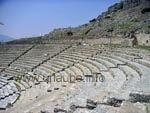
This rapidly changed at the complex of excavations itself, as due to the temperatures of 40 degrees and more, we nearly were the only visitors there. At the first station, the amphitheatre of the 4th century BC with a space for up to 4000 visitors, we rapidly came up with some clever citations just like that and presented them in mimic in the backdrop that was mainly in original condition. Only our casual clothing avoided in this concern the generation of an authentical reflection of the antique reality. During the further walkabout it became clear the all enumerated fragments, each single stone and the still existent wall fragments belonged to a merely endless puzzle, that, as far as possible, it was supposed to be constructed anew with the help of exactly fitting reproduced set pieces. At some columns with a height of several metres, as also at the bigger complexes as the amphitheatre, this process already took place, but thousands of partly broken relief panels and very heavily stone chippings were still waiting to be reassembled one day. 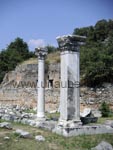
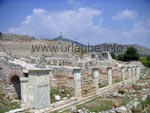
A sensational first view to the lower situated former city centre of Philippi followed, with the Forum Romanum sized 70 x 150 metres and the impressive ruin of a basilica of the roman time, which relicts were of a height of ten metres and more. Only the Via Egnatia, at this section a narrow, asphalted country road, was still to be crossed, but this undertaking resulted not to be completely smooth and nonhazardous, as there were numerous cars passing it with a considerable speed. Ultimately we trundled, one after the other, to the other side of the street and accessed a part of the complex that, despite its exposed situation, it still did not disclose all of its secrets. To the contrary, the antique urban structures that consisted on many conserved wall relicts, archways and columns, were clearly visible at the first sight. But it was not only the distribution of the city itself opened up to us viewers, but also the room distribution of the respective buildings. A circuit that was marked with arrows lead in the right order to the relicts of the residences, an extensive tessellated floor, dungeons, antique toilet facilities and last but not least, passing by the Forum Romanum and the basilica that could be completely visited and mainly also accessed. If one visualises that these structures and constructions on the spot are up to 2400 years old, the perspective also changes rapidly. The eyes look for the best possible perspective and try to add what the power of the nature and the intervention of the human beings have ablated and destroyed in the course of the centuries. At some areas, as for example the ones of the amphitheatre or the Forum Romanum, this is specially successful, specially, if the complex is nearly deserted. 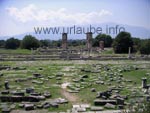
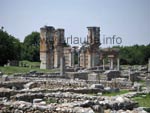
After we again visited the sightseeings with less shade at the time of the day with the highest heat, we enjoyed after a two hours tour to have a refreshment in the aforesaid restaurant, that we previously demonised. The soundscape was still bad, but apparently the only and very young barkeeper took the opportunity to hear his music very loudly. Also, there were not so many people he could have disturbed. However, we took it with humor, did not buy any of those expensive illustrated books and referred ourselves in direction to the Ammolofoi -beach at Nea Peramos, that I will further introduce in detail. At our homecoming in Paleochori in the evening, we were about to get introduced into a very special greek speciality, as we already planned during the previous evening to celebrate a greek party. We rapidly bought at Lidl a pallet of veltins water and were already expected by Kostas' family in the veranda. In total, they must have been about ten persons, that also did not doubt to ask us in greek language about our experiences of the day. Meanwhile, Kosta risked his neck by translating, and when he was confused, it also happened that he translated form german to german. While Jorgos put a bottle with a clear liquid on the table, his wife sorted the 150 CDs that people brought with greek music. Then the party started and we got informed about the name of the transparent liquid in the bottle: tsipouro, a popular schnapps that is distilled by many greeks themselves in the countryside - indeed by canisters. Apropos distilling - the alcohol content is somewhere between 40 and 70 per cent and the stuff first burns in the glass an then in the throat. The taste is similar to ouzo. Nobody should miss to have this drink, as it makes one to suddenly unterstand the greek language. The only problem is: the more greek one understands, the less capable is one to speak. At least I had this feeling, after I silently followed a three-hour discussion between Kosta and Jorgos, while all the others went long ago to bed. 
Back to the index Thessaloniki Copyright: Patrick Wagner, www.tourist-guide.biz |
||